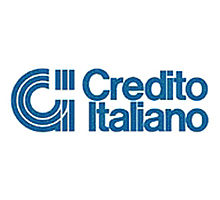Credito Italiano
This article needs additional citations for verification. (February 2016) |
 | |
Native name | Credito Italiano S.p.A. |
|---|---|
| Formerly | Banca di Genova |
| Company type | subsidiary |
| Industry | Financial services |
| Founded |
|
| Defunct |
|
| Successor |
|
| Headquarters |
|
| Owner | UniCredito Italiano (100%) |
| Parent | UniCredito Italiano |
| Subsidiaries | Adalya Banca Immobiliare |
| Website | www |
Credito Italiano also known as just Credit, was an Italian bank, now part of UniCredit. It was merged with Unicredito in 1998, forming Unicredito Italiano (now UniCredit). Circa 1999 to 2002 UniCredit created a new subsidiary of the same name to run the retail network of Credito Italiano. On 1 July 2002 the subsidiary received the assets of sister banks to become UniCredit Banca.
History
Founded on 28 April 1870 in Genoa[1] as Banca di Genova, it took part in the establishment of the Bank of Italy (Italian: Banca d'Italia) and opened the first trans-Atlantic banking business with Buenos Aires (1872).[2] Local shareholders were local nobility (Pallavicino and Balbi), bankers (Quartara, Polleri) and merchants (Lagorio, Dodero, Bacigalupo), creating an initial capital of 3 million Italian lira.
It acquired "Banca Vonwiller" of Milan, but a large national financial crisis led to refinancing by German banks and name change to "Credito Italiano" (1895). Later, it acquired "Banca Manzi" of Rome (1901) and "Banca Meuricoffre" of Naples (1905). Its headquarters moved to Piazza Cordusio opened a branch office in London in 1911.
First World War
At the commencement of the First World War, the executive directors of Credito Italiano and the Banca Commerciale Italiana – another German funded bank in Italy – were officially in favour of neutrality.[3] However these banks were the subject of a campaign by both Italian nationalists, spearheaded by L'Idea Nazionale and Liberals grouped around Francesco Saverio Nitti. Both these political initiatives had links with business rivals Gio. Ansaldo & C. and Banca Italiana di Sconto.[3]
Post war expansion
Following the war it acquired the "Banca del Monferrato", "Banca di Legnano", "Credito Varesino and the Swiss Banca Unione di Credito (1919), and in 1920 it joined the "Compagnia Finanziaria Nazionale" (1920); and established "Banca Italo-cinese", the "Banca Italo Viennese" and "Tiroler Hauptbank" (1920). In 1921 it opened offices in Paris and Berlin and later contributed to the establishments of Banca Italo Egiziana (1924) and Banca Nazionale di Albania (1925).
As a result of the great depression, it went bankrupt and was revitalized by Istituto per la Ricostruzione Industriale (1933–1990s).
Italian government introduced a law that forced bank to separate short term loan and medium loan business in 1936. Credito Italiano, along with two other "bank of national interests", BCI and Banco di Roma, had formed Mediobanca in 1946.
Privatization and expansion
In the 1990s the bank became a private company, as Italian government sold the stake of the bank. The bank also acquired Banca Popolare di Spoleto (about 50%) in 1992 and Banca Cattolica di Molfetta (35%) in 1994.
In 1995 the bank acquired a majority interests in Credito Romagnolo (and its subsidiary Banca Popolare del Molise) and Carimonte Banca (and its subsidiary Banca Popolare di Rieti), which was merged into Rolo Banca,[4] except Banca Popolare di Rieti was spin off from Carimonte.
Formation of UniCredito Italiano
In late 1998 Credito Italiano was merged with Unicredito, which Unicredito was absorbed into Credito Italiano, and Credito Italiano was renamed into UniCredito Italiano.[5][6] The original shareholders of Unicredito would owned about 38.46% shares of UniCredito Italiano.[7]
In the same year Banca Popolare di Spoleto (July), Banca Cattolica di Molfetta (October) were sold, as well as Banca Popolare del Molise and Banca Popolare di Rieti were merged into Rolo Banca and UniCredit in June 1998 and 1999. In December 1999, Credito Italiano was reestablished as a subsidiary (instead of a division within the company).[8]
UniCredit Banca
On 1 July 2002, Credito Italiano, as a subsidiary, was renamed to UniCredit Banca, which received the retail bank assets from Rolo Banca, Banca CRT, Cariverona Banca, Cassamarca, Cassa di Risparmio di Trento e Rovereto and Cassa di Risparmio di Trieste. On 1 January 2003 UniCredit Private Banking and UniCredit Banca d'Impresa were spin off from UniCredit Banca. In 2010 the bank was completely absorbed into UniCredit.
See also
- Banco di Chiavari e della Riviera Ligure, another Ligurian bank
- Banca Carige, another Genoa-based bank
References
- ^ Credito Italiano overview from University of Bologna Archived April 11, 2005, at the Wayback Machine
- ^ history Credito Italiano (n.d.). International Directory of Company Histories. Retrieved February 29, 2008, from Answers.com Web site: http://www.answers.com/topic/credito-italiano [unreliable source?] Archived November 4, 2012, at the Wayback Machine
- ^ a b Forsyth, Douglas J. (2002). The Crisis of Liberal Italy. Cambridge University Press. ISBN 9780521891615. Retrieved 17 September 2018.
- ^ https://www.unicreditgroup.eu/it/unicredit-at-a-glance/our-identity/our-history.html
- ^ "UNICREDITO - S.p.a." Gazzetta Ufficiale (in Italian). 3 July 1998. Retrieved 13 February 2016.
- ^ "CREDITO ITALIANO" (in Italian). Italian Republic Official Gazette. 27 August 1998. Retrieved 1 March 2016.
- ^ "Provvedimento N°24: Credito Italiano / Unicredito" (PDF) (in Italian). Banca d'Italia. 2 November 1998. Retrieved 3 March 2016.
- ^ "A TUTTI I NOSTRI CORRISPONDENTI" (in Italian). UniCredit. 9 December 1999. Archived from the original on 5 March 2001.
External links
- Official website (currently redirect to UniCredit)
- Defunct banks of Italy
- UniCredit Group
- Credito Italiano Group
- Former UniCredit subsidiaries
- Banks established in 1870
- Banks disestablished in 2002
- 1870 establishments in Italy
- Italian companies disestablished in 2002
- Formerly government-owned companies of Italy
- Companies based in Genoa
- Companies based in Milan
- Re-established companies
